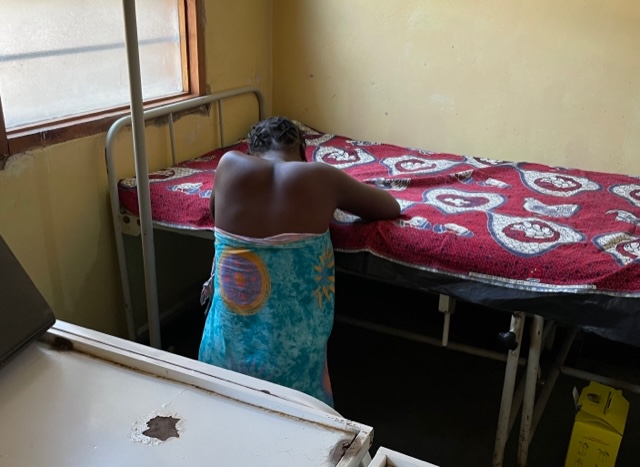Another busy and fascinating week working as a midwife in Malawi. I was glad to be able to buy a bar of soap, one of only three they had in the local pharmacy. I am definitely struggling with soap being a luxury product. This week I have been thinking about fetal positioning.
Monday morning was super busy meaning that I had supported 3 women to birth before 11am. Each of these births was quick and straightforward. All three had been staying at the shelter and arrived in the delivery ward in active labour. Their expectation (and that of the staff) is that as soon as they come to the ward they will lie on the bed, flat on their back, without even a single pillow, until baby is born. I’ve spent many years as a midwife in the UK encouraging women to remain active and upright throughout birth, and discouraging women from lying on their back in the third trimester due to concerns about the baby’s weight causing compression of the woman’s aorta https://www.tommys.org/pregnancy-information/im-pregnant/sleep-side/sleep-position-pregnancy-qa The majority of babies I’ve seen born here have been around 2.5-3.2kg, so not particularly small. I am interested to observe that most women and babies seem unaffected by this position.
I have been encouraging women to move around, but this is challenging when the three beds are very close together. There is barely room to stand between them.
An observation that I have been thinking a lot about this week is the position that babies take up in the last few weeks of pregnancy (fetal positioning). As a midwife in the UK, I commonly see babies in the last few weeks of pregnancy settling into an LOA position. I was taught that this is the optimal position for a baby to be in prior to birth and that it gave more room for the baby to align well. The presence of the liver on the left side perhaps means that there is a bit more room on the left. I was taught that we should encourage women to actively work to encourage this position because it is “best”. This has been challenged in the last 10 years or so, but is still widely believed. https://obgyn.onlinelibrary.wiley.com/doi/pdf/10.1002/uog.13189. I have seen a great deal of stress caused to women who believe that their baby is in the “wrong” position. Certainly a large proportion of babies I see in the UK are in a LOA position at the start of labour. A significant number are in OP (back to back) positions.

As a midwife in Malawi, almost every baby I see at the start of labour is on the other side, ROA. Does nature get is “wrong” in most cases here? So far I have seen very few LOA presentations and have only found one baby back to back (out of several hundred I have examined). It is much more difficult (and probably uncomfortable) for a baby to remain in a posterior position when the woman commonly sit or stands upright. Few babies are born in an OP position, most turning to an anterior position during the process of labour. This takes time. In the UK it has become commonplace for women to worry a great deal about an OP position, and some are very worried about anything other than LOA. Many will use techniques referred to as optimal fetal positioning or as taught by organisations such as Spinning Babies
https://www.spinningbabies.com/why-this-is-not-optimal-fetal-positioning/
I assume that the upright posture and the active nature of women in rural Malawi helps their babies to birth quickly and easily. Their abdominal walls tend to be strong, supporting the baby into a good alignment with the pelvis. In our, often sedentary, lives in the UK, our bodies are perhaps more challenged. I encourage clients to have an assessment and to take advice about posture and exercise from a specialist osteopath or chiropractor from early in pregnancy. Tensions in our bodies and poor habits caused by our desk and car based lives can make it hard for our bodies to work well. Ideally this work starts before pregnancy and is something I discuss in pre-conception consultations https://yourmidwife.org.uk/planning-pregnancy/. I am glad to have a wide network of perinatal professional specialist colleagues, including those at https://www.sussexbirthandbabycollective.com/

I remain curious about why such a huge o proportion of babies in Malawi lie on the right. I It is so overwhelmingly the case here that I have watch students struggle to auscultate (listen to) the fetal heartbeat, then being astonished when I have palpated to identify baby’s position and suggested that they try the other side! A very reasonable suggestion made by a colleague is that a great many people here have an enlarged spleen which will be taking up space on the left side of the woman’s abdomen https://my.clevelandclinic.org/health/diseases/17829-enlarged-spleen Given the quick and effective labours which I am repeatedly seeing here, I conclude that we should focus more on good posture and tone, and then let our bodies work with our babies to prepare for birth.

So, here starts another week. Admin tomorrow morning, I have come to Nkata Bay to find the passport and immigration office to get my visa extended up to the full 90 days that I plan to be here. I’m very grateful that the senior team at Nkata Bay hospital ( the regional centre that I have transferred women to) have agreed that I can visit for a few days to understand what services and facilities they can offer.


1 Comment
Great blog Angie 👍 thank you